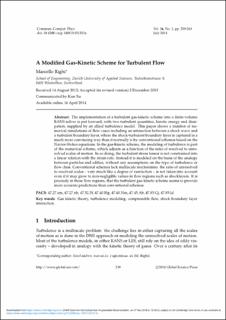Please use this identifier to cite or link to this item:
https://doi.org/10.21256/zhaw-4907Full metadata record
| DC Field | Value | Language |
|---|---|---|
| dc.contributor.author | Righi, Marcello | - |
| dc.date.accessioned | 2018-11-30T09:38:55Z | - |
| dc.date.available | 2018-11-30T09:38:55Z | - |
| dc.date.issued | 2014-07 | - |
| dc.identifier.issn | 1815-2406 | de_CH |
| dc.identifier.issn | 1991-7120 | de_CH |
| dc.identifier.uri | https://digitalcollection.zhaw.ch/handle/11475/13398 | - |
| dc.description | Published online: 16 April 2014, erworben im Rahmen der Schweizer Nationallizenzen (www.nationallizenzen.ch) | de_CH |
| dc.description.abstract | The implementation of a turbulent gas-kinetic scheme into a finite-volume RANS solver is put forward, with two turbulent quantities, kinetic energy and dissipation, supplied by an allied turbulence model. This paper shows a number of numerical simulations of flow cases including an interaction between a shock wave and a turbulent boundary layer, where the shock-turbulent boundary layer is captured in a much more convincing way than it normally is by conventional schemes based on the Navier-Stokes equations. In the gas-kinetic scheme, the modeling of turbulence is part of the numerical scheme, which adjusts as a function of the ratio of resolved to unresolved scales of motion. In so doing, the turbulent stress tensor is not constrained into a linear relation with the strain rate. Instead it is modeled on the basis of the analogy between particles and eddies, without any assumptions on the type of turbulence or flow class. Conventional schemes lack multiscale mechanisms: the ratio of unresolved to resolved scales – very much like a degree of rarefaction – is not taken into account even if it may grow to non-negligible values in flow regions such as shocklayers. It is precisely in these flow regions, that the turbulent gas-kinetic scheme seems to provide more accurate predictions than conventional schemes. | de_CH |
| dc.language.iso | en | de_CH |
| dc.publisher | Global Science Press | de_CH |
| dc.relation.ispartof | Communications in Computational Physics | de_CH |
| dc.rights | Licence according to publishing contract | de_CH |
| dc.subject | Physics - fluid dynamics | de_CH |
| dc.subject.ddc | 530: Physik | de_CH |
| dc.title | A modified gas-kinetic scheme for turbulent flow | de_CH |
| dc.type | Beitrag in wissenschaftlicher Zeitschrift | de_CH |
| dcterms.type | Text | de_CH |
| zhaw.departement | School of Engineering | de_CH |
| zhaw.organisationalunit | Institut für Mechanische Systeme (IMES) | de_CH |
| dc.identifier.doi | 10.21256/zhaw-4907 | - |
| dc.identifier.doi | 10.4208/cicp.140813.021213a | de_CH |
| zhaw.funding.eu | No | de_CH |
| zhaw.issue | 1 | de_CH |
| zhaw.originated.zhaw | Yes | de_CH |
| zhaw.pages.end | 263 | de_CH |
| zhaw.pages.start | 239 | de_CH |
| zhaw.publication.status | publishedVersion | de_CH |
| zhaw.volume | 16 | de_CH |
| zhaw.embargo.end | 2019-07-01 | de_CH |
| zhaw.publication.review | Peer review (Publikation) | de_CH |
| Appears in collections: | Publikationen School of Engineering | |
Files in This Item:
| File | Description | Size | Format | |
|---|---|---|---|---|
| 2014_Righi_A_modified_gaskinetic_scheme_for_turbulent_flow.pdf | 4.06 MB | Adobe PDF |  View/Open |
Show simple item record
Righi, M. (2014). A modified gas-kinetic scheme for turbulent flow. Communications in Computational Physics, 16(1), 239–263. https://doi.org/10.21256/zhaw-4907
Righi, M. (2014) ‘A modified gas-kinetic scheme for turbulent flow’, Communications in Computational Physics, 16(1), pp. 239–263. Available at: https://doi.org/10.21256/zhaw-4907.
M. Righi, “A modified gas-kinetic scheme for turbulent flow,” Communications in Computational Physics, vol. 16, no. 1, pp. 239–263, Jul. 2014, doi: 10.21256/zhaw-4907.
RIGHI, Marcello, 2014. A modified gas-kinetic scheme for turbulent flow. Communications in Computational Physics. Juli 2014. Bd. 16, Nr. 1, S. 239–263. DOI 10.21256/zhaw-4907
Righi, Marcello. 2014. “A Modified Gas-Kinetic Scheme for Turbulent Flow.” Communications in Computational Physics 16 (1): 239–63. https://doi.org/10.21256/zhaw-4907.
Righi, Marcello. “A Modified Gas-Kinetic Scheme for Turbulent Flow.” Communications in Computational Physics, vol. 16, no. 1, July 2014, pp. 239–63, https://doi.org/10.21256/zhaw-4907.
Items in DSpace are protected by copyright, with all rights reserved, unless otherwise indicated.